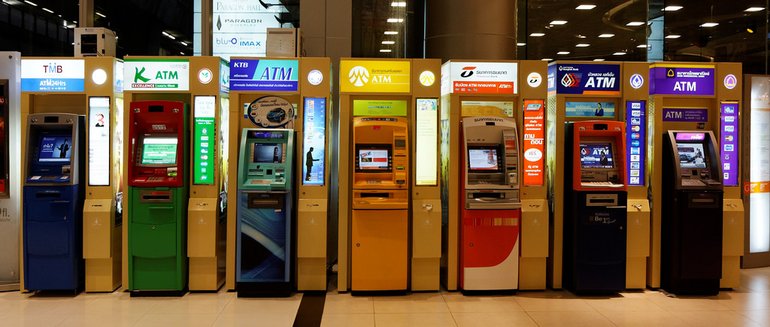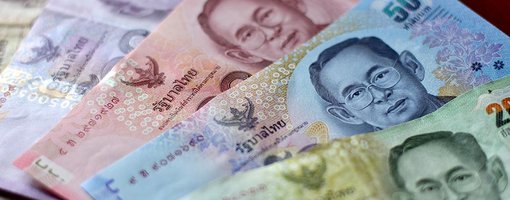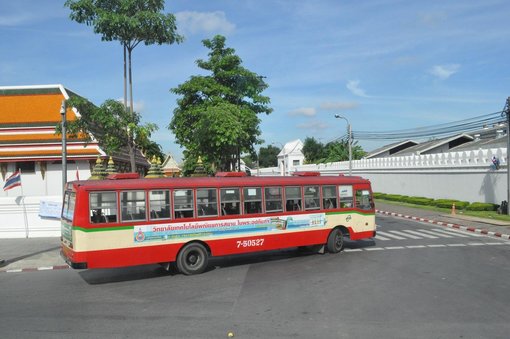Thai ATM swallowed my card!
"For security reasons all cards that have been retained by ATMs are destroyed." (Bangkok Bank Website)
This is now the stated policy of all Thai Banks. In the case of overseas visitors using cards to make cash withdrawals, retained cards are now routinely destroyed on the explicit instructions of foreign banks using Thailand’s ATM Network.
Please do not vent your anger and frustration on Thai bank staff if this happens to you. They have played no part in creating your predicament, any more than innocent bystanders who have no power to intervene should they witness an illegally parked car being clamped by the traffic cops while the car owner stands in line to take cash from the local ATM. Most civilized human beings would assume the car owner had completely lost his marbles if he remonstrated with said pedestrians and accused them of being responsible for clamping his wheels and demanding, in no uncertain terms, they immediately liberate his car.
There are a number of reasons why an ATM will retain a customer's card. The three most common are:
1. You have inadvertently keyed in the wrong PIN (Personal Identification Number) three times in succession.
2. You have not advised your bank you are traveling overseas.
3. You waited too long before withdrawing your card from the machine.
Wrong PIN
This is the most common reason for an ATM to swallow your card. It is easily done, given we are expected to remember so many passwords for credit cards, Internet banking access, email accounts and so on and so forth. If you have more than one card you use for ATM transactions, it is quite common to make the mistake of inputting the right PIN but for the wrong card. Also, if you see an error message on the screen after keying in the PIN, panic and confusion are normal reactions which may lead to a jumbled second and third attempt to get the code right. It is no good you storming into the branch and telling bank staff you are 100% certain you keyed in the correct PIN. The fact of the matter is that your card’s issuing bank has not recognized the validity of the code you punched into the machine, and has sent an electronic signal to the local ATM to retain your card. Given the increasing rates of world-wide credit / debit card crime, ATM network services are routinely instructed by the issuing banks to destroy and not return cards to customers who report the ATM has swallowed his or her card.
It makes no difference if you eject the card after your first failed attempt, to try your luck at another ATM. The magnetic stripe, or the chip embedded in the card, records the attempt to withdraw cash, and this is immediately read by the next ATM you try. If you correctly insert the PIN and complete the transaction, the count on the magnetic stripe or embedded chip is reset to zero. However, if you again use the wrong PIN the card records two strikes against you. If the wrong PIN is used for a third consecutive time, then, sorry, “Three strikes and you’re out.”
In a nano-second, the issuing bank’s system automatically sends an electronic message to the ATM you are using to retain or capture your card. An error message appears on the screen advising there is a problem with your card and asks you to contact your bank. At the same time, your card is automatically blocked to prevent further use. The ATM should spew out a receipt for the retained card which includes a code recording the reason your card has been captured. In the moment of horror you realise your card has gone, many people fail to notice this small piece of paper and walk away from the machine in search of help.
It is possible for your bank to re-set the PIN but, these days, banks seem to prefer the convenience of cancelling the retained card and issuing a new card. When I say “convenience”, I am, of course, referring to your bank’s convenience, not yours.
The instruction to contact “your bank” is clearly displayed on the ATM screen. In the majority of cases, visitors to Thailand will not be using an ATM belonging to “their bank” and are in no position to expect or demand assistance or help in resolving the problem from local bank staff. Branch staff do not have the authority to overrule your issuing bank's instructions to retain the card, and, even if they contravened bank policy and did so, the card is useless as it will have automatically been blocked from further usage if you keyed in the wrong PIN three times in a row.
Moreover, Thai bank staff have no way of verifying you are the legitimate “owner” of the card issued by another financial institution, even if you produce your passport or other photo-ID. It may seem like the bank staff are being overcautious, but they are simply following your bank's instructions.
Even back home, if your card is retained by the ATM outside the branch where your bank account is held, it can take some time for your card can be returned to you. In many cases branch staff do not have the keys to unlock the ATM, as banks increasingly contract out the ATM service to security companies along with complete responsibility for the operation of the ATMs. In some cases the ATMs are on a time lock and branch staff may not have the level of authority to over-ride the lock. In other cases branch staff may hold the keys, but for security reasons there are two keys and two different locks to access the internal workings of the ATM. If one of the two key holders is at lunch or in a meeting, or if the banking hall is very busy with all hands on deck, you will most likely be asked to return to the branch the following day and advised to bring photo-ID and/or your latest bank/card statement as proof you are the legitimate “owner” of the card.
My use of quotation marks around “owner” in the preceding paragraphs is deliberate. If you have ever read the small print of the Terms and Conditions sent by the Bank with your new ATM/credit/debit card, you will know the Bank remains the owner of the card and is at liberty to cancel the card at any time and at its discretion, and without prior notice lower cash withdrawal limits. These T&Cs, as they are known in the trade, are written in such a way you have no legal redress if the Bank’s ATM retains your card, even if the Bank is at fault and you are considerably inconvenienced. It also means that if your card is swallowed inside another bank’s ATM, you cannot march into the branch and claim your card has been stolen by their machine. Or, even more bizarrely, call the police and insist they remove the ATM from the premises as forensic evidence in a crime. I do not jest. You would be amazed at the different reactions people display when their ATM card is swallowed.
Having your card retained by an ATM can be particularly frustrating if you are traveling overseas. The experience is aggravated when you are visiting a country where you are not fluent in the native language and bank staff are not fluent in yours.
Let's say it is the start of a once-in-a-life-time holiday somewhere in Thailand. On Day One, your ATM card is swallowed and disappears into the bowels of a Thai bank's ATM.
Your heart sinks, but the bank is still open, so you queue up to explain your predicament to a teller. When she explains, perhaps in broken English, the branch cannot retrieve and return the card and that you should contact your own bank for help, the sinking feeling you felt as your card was swallowed, can suddenly transform you from a meek and mild law-abiding citizen into the Green Hulk as you explode in anger when you realize you have no immediate access to your own cash and have a cash flow problem on-the-verge-of-bankruptcy proportions.
If you allow your emotions to boil over, rant and rave, and tell the bank staff it is their fault your car wheels have been clamped and that their bank’s ATM is rubbish, the teller who smiled at you and explained things in reasonable English, suddenly only speaks Thai. Be certain of this, if you demand to speak to a manager, they will back their staff to the hilt, as they should do, as the staff is simply explaining the instructions received by the ATM Network of your bank back home.
Travelling overseas
If you have not advised your bank of your travel plans, do not be surprised if your ATM card is swallowed when you try to make a cash withdrawal from some exotic location in Thailand.
When you insert your card into the ATM your bank’s system is alerted to the fact you are in, say, Koh Samui, and want to take cash from an ATM machine. The system checks whether this is normal or expected behaviour. If the answer is “No,” your bank’s system sends a message to the ATM in Koh Samui to retain the card. The assumption is that your card has been stolen or cloned, sold into an underworld inhabited by rogues and criminals, and that the transaction you are trying to complete is fraudulent.
You may have phoned your bank before you left home and confirmed your travel plans in writing, but sometimes the back office staff in your home country fail to update these details before your travel date. In this case it is pointless venting your spleen on local Thai staff, when the fault lies with your bank's staff back home.
Part of the answer to this is to give your bank plenty of notice of your travel plans and confirm these in writing if you contact the bank by phone. One week before you travel, phone your telephone banking centre, refer to the date of your letter, but not the content, and ask the staff “Where will I be next week?” If there is embarrassed silence at the other end of the phone, ask to be put through to the most senior staff on duty within the call centre. Explain you have contacted the bank twice by phone and in writing advising your travel plans, and then ask why this information has apparently not been added to your account details. Ask for the supervisor’s name and write it down together with the time and date of your telephone call. All telebanking calls are recorded and retained for at least one month. If you encounter problems in using your card in an overseas ATM, being able to phone your bank with the details of the time, date and name of the staff you spoke to, makes it very difficult for them to tell you there are “no details on our records of you previously advising us your travel plans.”
Timed out
Unfortunately, there is no universal agreement among ATM providers as to the sequence of a cash withdrawal transaction.
Critically, taking your cash and retrieving your card is reversed in different Bank ATMs in Thailand.
Many customers, who are used to retrieving their card before taking cash from the machine, walk away from the ATM without retrieving their card as they are on “automatic pilot” and taking the cash is ingrained as the last step of the process.
Also, in this same situation, many customers automatically start counting and checking the amount of cash spewed out by the ATM, oblivious of their card begging to be retrieved from the jowls of the dinosaur, until it is too late!
Those who are already savvy, and those who will become so after reading this article, will stand before the Almighty Thailand Munificent machine and expect each step of the transaction to be different from their experience in their home country. Reading the instructions on the ATM screen, which guide you through the transaction process, is helpful.
Having read this article, you will hopefully remain calm and collected if you find your card swallowed by an ATM. Treated in the right way, if the ATM is situated outside a bank, the branch staff may well take pity on your circumstances and provide you access to the branch internet connection so that you can email or Skype your bank immediately to report the problem. At the very best, you can expect tea and sympathy, but little else.
Having read this, you may also be spurred to take more precautions not to expose yourself in the first place to the risk of having your ATM card captured and finding yourself an Alien in a foreign land where you do not speak the language, without access to your cash. You may call me a pessimist, but if you use a card in an overseas ATM you should assume it will be swallowed at the most inconvenient moment of your holiday and be very surprised and relieved when it is not.
Take a belt and braces approach to the business of getting local currency as and when you need it. For example:
- Never travel overseas with only one means of accessing cash
- If you have more than one credit / debit card be sure to take at least one other card with you. If you rarely use this back up card at home, be sure to make a note of the card number, and the telephone number to contact if your card is lost or stolen or swallowed by an overseas ATM.
- If you only have one card, then take traveller’s cheques and / or cash to buy local currency and use these as your primary access to cash with your card as back up. Also if you are able to do so, make a retail purchase with the card before inserting it into the ATM. If there is a problem and you are not able to use the card to make a purchase, at least you will still have the card, and can contact your bank to find out why you cannot use it.
- Buy the highest denomination of travellers cheques or take high denomination currency notes. These attract a slightly higher rate of exchange than lower value notes.
- If you elect to travel with high denomination currency notes, be sure to ask your bank for new notes as in many countries when banks are presented with foreign currency notes that are torn, scribbled on, or simply old and dirty, you will not be able to exchange them. I can explain why this is the case, but it would take too long. Please just accept that you have to present pristine currency bills from your country if you want to exchange them freely for Thai Baht.
- Keep your crisp new notes flat and protect from moisture by wrapping them in cling film or a carrying them in a ziplock bag until you need to sell them. Independent money changers are more accommodating in accepting damaged notes, but you need to be sure the money changer is properly licensed to avoid exchanging legitimate bills for forged notes. If you use a money changer, make a point of randomly selecting 10 of the notes they have given you and ask them to show them to you under the ultraviolet light machine they will have used to check the watermarks on the bills you want to exchange. Or download one of the many free Counterfeit Money Detector apps onto your Smartphone and make a flamboyant display of subjecting each note you are given to forensic scrutiny. The last thing you want during your holiday of a life time is to be arrested on suspicion of using counterfeit Thai Baht to pay for a couple of beers.
- Take photographs on your smart phone of all the cards you are carrying with you (front and back) so that you have telephone contact numbers for reporting the loss or theft of a card, and the number on the front of the card, and the 3 digit security number on the back of the card. If you have the telephone contact number to report your card as lost or stolen, think how ridiculous it must seem to the customer service staff when they ask, “And what is your card number?” and you reply, “I don’t know – my card has been stolen!” You are thinking, “What an idiot! How can I know the number on my card if I don’t have it?” At the other end of the phone the customer service staff is thinking along similar lines: “Who is this idiot phoning in to report the loss of his/her card and doesn’t even know the card number?”
- Off topic but relevant, while you are taking photos on your phone of your credit/debit cards, take photographs of your passport, air tickets, hotel vouchers, travel insurance documents, travellers cheques, and any other documentation relating to your overseas trip. Email everything to your own Email address. This way, if all your travel documents, credit cards, smart phone or tablet are lost or stolen, you can print off a copy of these documents in an internet café to present to the local police force and/or your embassy or consulate for help.
- Try only to use ATMs that are outside or inside a bank during opening hours. If your card is retained you can at least expect the bank staff to investigate whether there has been a mechanical failure, e.g. a power outage has interrupted normal ATM service or the internal mechanism has jammed. If the ATM has broken down, you are much more likely to get your card back – although it may not be until the next day if the branch does not have the keys to open the ATM or an engineer is not immediately available to fix the problem.
- Avoid using ATMs outside/inside convenience stores – if there is a problem, the most help you are likely to receive is being given the telephone number of the ATM operator to make a report.
- If your card is retained, contact your own bank as soon as possible and cancel the card. You do not want to compound your woes by risking an unscrupulous person keeping your card when the ATM is emptied. If your card is retained because you waited too long to take it back, it will not have been blocked by your bank and remains active.
- As an extra precaution, take a photo on your phone of the ATM and get the name, address and telephone number of the bank branch or convenience store. If the ATM is standalone, then take a photo of the nearest street sign, so if you are asked by your bank, you are able to provide the exact location of the ATM which swallowed your card. Use the option to include the time and date on your photos. Save the location to Google maps if you have Internet access.
I have no doubt there will be responses to this article stating Thai bank staff were extremely helpful and retrieved a retained card. There are always exceptions to the rule, and in the case where the ATM itself has malfunctioned (for example, a sudden power outage) you are more likely to get your card back if it is not captured on instructions of your bank.
See also
Accommodations
Tours and activities
James Bond Island & Sea Cave Canoe Tour From Phuket
Zoom around Phang Nga Bay on this 10-hour day trip from Phuket. Visit the fishing village of Koh Panyee and canoe around Khao Phing Kan, the island made famous in the 1974 James Bond movie. All transportation and lunch included.
Group Tour - Kompong Khleang Floating Village
Experience the Great Tonle Sap Lake and meet the residents of Kompong Khleang Floating Village who call it home. Tour highlights include local snacks - like fresh sticky rice and palm sugar donuts - a drive through the countryside, a visit to Kompong Khleang, the largest floating village in Siem Reap, and a boat ride out to the Tonle Sap Lake.





anonymous
Jul 23, 2019 at 23:48
I have no doubt there will be responses to this article stating Thai bank staff were extremely helpful and retrieved a retained card. There are always exceptions to the rule, and in the case where the ATM itself has malfunctioned (for example, a sudden power outage) you are more likely to get your card back if it is not captured on instructions of your bank.